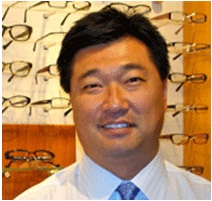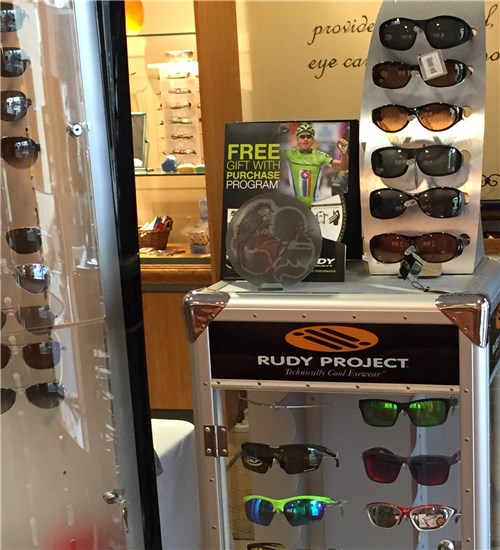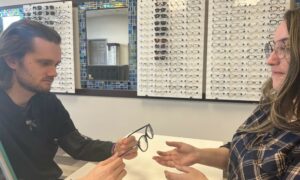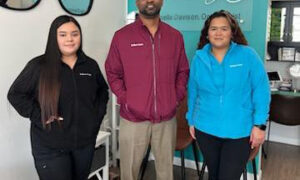By Yoongie Min, OD
May 20, 2015

SYNOPSIS
Set your practice apart by offering premium protective sports eyewear—and talking to patients and families about it.
ACTION POINTS
SELECT TOP PRODUCTS. Find the right mix for your geographic area.
PRICE PRODUCTS COMPETITIVELY. The price range for sports eyewear is typically $300-$750.
EDUCATE PATIENTS. Cite examples from your family or patients of why eyes need to be protected while playing sports.
Protective sports eyewear keeps your patients’ eyes safe while they participate in activities important to their lives. When managed well, they alsoprovide your optical a growth opportunity.
Select Products
There are a limited number of companies that do specifically sports-related eyewear. We based our decision on which brands to sell after visiting the booths of sports eyewear manufacturers at Vision Expo East and West.
We look for companies that can serve a specific need or price point.In our office, we carry two main lines of sports eyewear, Liberty Rec Specs and Rudy Project. We use Rudy Project because they have so many different sports and activities that they make eyewear for. We use Liberty Rec Specs because they have a moderate price point that most parents can afford for their children.
Liberty and Rudy Project are both well known companies in the optometric community. Liberty Rec Specs come in non-prescription styles, and most of their frames can also be made into prescription lenses. Rudy Project carries hundreds of different frames to match almost any sport, and are also available with non-prescription and prescription lenses.
The Rec Specs often have protective rubber padding at the temples, and, also, at the nose. They are also more substantial than the pre-made safety eyewear that you can find at places like Home Depot or Lowes, or the basic safety eyewear provided by some companies to their employees. Some of the styles have regular temples and others are able to be strapped around the head. Rudy Project comes in many styles, some of which look like traditional sunglasses and others that look more blade-like (similar to Oakley). Rudy Project, in particular, comes in almost any combination of tints, coatings and colors that you could imagine.
Make the effort to browse these protective sports eyewear brands at optical trade shows, so you can decide which types work best for your geographic area. Some areas of the country are much heavier in activities such as skiing, biking and golf than others, so every practice needs to identify the sports they can best target.

This Rudy Project protective sports eyewear display is prominent in Dr. Min’s office. Dr. Min says it is important to talk to every patient about protecting their eyes while playing sports.
Place Near Children’s Eyewear in Optical
We have our Rec Specs line right next to our children’s frame board because they seem more geared toward children and teens. We want to make it easy for parents to look at these specialized frames at the same time they are shopping for regular frames.
The challenge in trying to categorize sports eyewear is that some patients get “sports” eyewear frames with no intention of using them for sports; they just like the appearance of the frames. So, you may want to consider featuring them side-by-side with your other sunglasses. Our Rudy Project frames are in our general sunglass area because many adults wear them as regular sunwear, in addition to wearing them when playing sports. They are stylish, and can pass easily for sunglasses.
Price Sports Eyewear Merchandise
The price of sports eyewear can vary dramatically based on the frame and whether the lenses are single-vision or multifocal, and which lens treatments and tints are added. The price range for sports eyewear is typically $300-$750. It is a relatively small percentage of our overall optical revenues–I would estimate between 5-10 percent.
The margins and profitability may not be quite as high on these frames compared to dress eyewear. We tend to use a lower markup on sports frames, but the same markup on lenses.
Profitability also depends on how each office handles the sale because many times the sports glasses are a second-pair purchase. Some laboratories give a significant second-pair discount on lenses. For example, our lab gives us a 50 percent discount on second-pair lenses that are ordered the same day.
Each office needs to decide whether to pass along a discount or not. We do pass this on because we still make a profit on the lenses and on the frame, as well. The discount also sends the message that sports glasses are more of a need or necessity than a luxury, and may encourage patients to continue getting or updating sports eyewear in the future.
Educating Patients About Sports Eyewear:
The Touch Points
• Discuss it on your web site.
• Promote it through signage & displays.
• Train opticians on the details of the sports eyewear you sell.
• Reinforce by asking every patient about the need for it.
Educate All Patients About Need to Protect Eyes
Liberty and Rudy Project provide us with point-of-purchase materials, but ultimately, the responsibility falls on us to promote and discuss protective sports eyewear options with patients. The advice of the doctor is still paramount in helping patients decide which types of eyewear they need.
The target demographic for sports eyewear includes all ages and anyone who is active or participates in sports. However, we definitely target youth and teens, and initiate discussions with parents about safety and injuries.
In addition, more adults are active now well into their later years, and we often target those individuals for activities such as golf, tennis and biking.
With parents, we discuss the possibilities of injuries such as concussions, trauma and abrasions of the eye, and sun protection. I often use my own son, who used to play baseball in high school, as an example. He fouled a pitch back into his face and broke his nose and orbital bone.
We use second-pair discounts to try and improve sales, and we also try to make sure that any vision plan benefits are used. For example, if a teen has eyewear benefits through a parent, but does not need new clear eyewear, we often encourage the parents to use the benefits for sports eyewear or sun eyewear.
Educate Opticians
Your opticians need to know all of the different lens and frame options your sports eyewear vendors offer, along with which prescriptions can be put into which frames since not all frames are conducive to every Rx. That can be difficult because there are so many options for patients to choose from. The use of print and online product catalogs and pictures from vendors is helpful when working with patients to choose the option that’s best for them. We also use iPads in our optical area to show patients the different styles and colors available in sports eyewear.
Yoongie Min, OD, is the owner of Northwest Vision Center, with locations in Columbus and Chillicothe, Ohio. To contact him: yminod@rrohio.com.

























